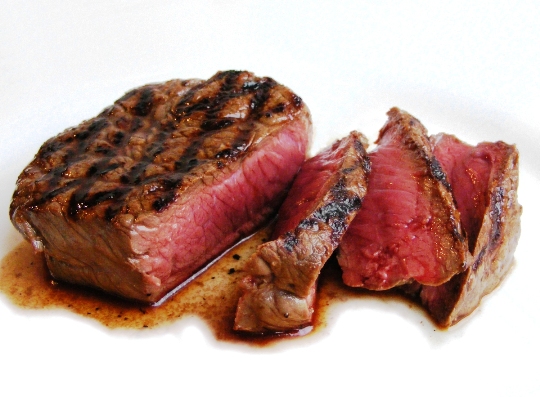How many of you out there know what temperature your ground beef should be cooked to? What about pork? Chicken?
As producers, it is our duty to provide consumers with the safest possible product we can. And in the scheme of things, I’ve said before that I think our food system is pretty darn safe. See post here. But even if we produce the safest product possible, the responsibility at the end still falls upon the consumer to be the one to cook it and handle it properly. How am I the one responsible for someone getting sick when they didn’t cook their meat all the way through, or that they cross contaminated using raw utensils on cooked food without washing them? Sounds crazy, but the meat industry all the time gets blamed for improper consumer handling when people get sick. Not to say that we don’t take responsibility when needed because that is indeed what a recall is doing. It is showing that the system put in place is working. And I applaud you all reading this for taking steps to be an informed consumer, those are the best kind. 🙂 I know everyone has their little tips and tricks for figuring out doneness in meat, but really a good meat thermometer is a great way to ensure proper temperatures are being met.
Straight from USDA the guidlines for proper internal temperatures are as follows:
USDA Recommended Safe Minimum Internal Temperatures
- Cook all raw beef, pork, lamb and veal steaks, chops, and roasts to a minimum internal temperature of 145 °F as measured with a food thermometer before removing meat from the heat source. For safety and quality, allow meat to rest for at least three minutes before carving or consuming. For reasons of personal preference, consumers may choose to cook meat to higher temperatures.
- Cook all raw ground beef, pork, lamb, and veal to an internal temperature of 160 °F as measured with a food thermometer.
- Cook all poultry to a safe minimum internal temperature of 165 °F as measured with a food thermometer
Alright now some of you are probably thinking 145 °F for beef!? Please take note, if you cook your beef steak to the recommended temperature, IT WILL BE OVER DONE! A better chart for determining doneness on beef products such as steaks can be found on sites as simple as Wikipedia. It is important to note that this is for WHOLE MUSCLE cuts, NOT ground meat.
| Term (French) | Description | Temperature range[1] | USDA recommended[2] | |
|---|---|---|---|---|
| Extra-rare or Blue (bleu) | very red and cold | 46–49 °C | 115–120 °F | |
| Rare (saignant) | cold red center; soft | 52–55 °C | 125–130 °F | |
| Medium rare (à point) | warm red center; firmer | 55–60 °C | 130–140 °F | 145 °F |
| Medium (demi-anglais) | pink and firm | 60–65 °C | 140–150 °F | 160 °F |
| Medium well (cuit) | small amount of pink in the center | 65–69 °C | 150–155 °F | |
| Well done (bien cuit) | gray-brown throughout; firm | 71-100 °C | 160-212 °F | 170 °F |
| Overcooked | blacken throughout; crispy | >100 °C | >212 °F | >220 °F |
Hmmm… So now some of you are probably wondering…? If I cook my steak to 120-130 so it’s rare and juicy, am I taking a healthy safety risk in doing so!? Food Scientist Harold McGee (via Food Network) gives us a GREAT explanation:
“…meats inevitably harbor bacteria, and it takes temperatures of 160 degrees Fahrenheit or higher to guarantee the rapid destruction of the bacteria that can cause human disease-temperatures at which meat is well-done and has lost much of its moisture. So is eating juicy, pink-red meat risky? Not if the cut is an intact piece of healthy muscle tissue, a steak or chop, and its surface has been thoroughly cooked: bacteria are on the meat surfaces, not inside. In other words, with whole cuts of meat it is the external temp, not the internal temp that must exceed 160 degrees Fahrenheit. Normal cooking methods-sautéing, grilling, roasting, braising, etc.-raise surface temperatures far above 160 degrees Fahrenheit. (To get a sense of this, consider that meat only begins to brown at 230 degrees Fahrenheit.) People very rarely get sick from rare or medium rare meat. Ground meats are riskier, because the contaminated meat surface is broken into small fragments and spread through the mass. The interior of a raw hamburger usually does contain bacteria, and is safest if cooked well done. Overwhelmingly, people get sick from the way meat is handled in the home: from cross-contamination, lack of cleanliness and holding meat at dangerous temps. Internal temperature should be the least of your worries.”
So feel free to eat the pink, juicy. medium rare steak! That’s how we eat our steaks at the Dewey household and we do so in complete confidence, no fear of the safety of our food! In fact, rarely do I worry about the meat that I eat, whether it be commercial beef we receive from large packinghouses or something that was butchered by us (custom exempt). I think that should speak volumes for the integrity I distill in our meat industry and the people who are out there trying to make the safest products possible.
Happy Friday everyone!




Reblogged this on Real Life Farm Wife and commented:
Do you really know to what temp to heat your meat?
Thank you for sharing this great info!
I’ve long been a fan of “just brown it on the outside” steaks. I have a heck of a time getting hubby’s done enough for his tastes…now I can go by temperature.
Pingback: Fun Meat Fact Friday: Most Commonly Asked Meat Questions | Chico Locker & Sausage Co. Inc.
Pingback: Happy Blog Birthday to Us! Counting Down our Most Popular | Chico Locker & Sausage Co. Inc.
Pingback: National Beef Month | Chico Locker & Sausage Co. Inc.
Pingback: Reporter Goes Undercover as USDA Meat Inspector | Chico Locker & Sausage Co. Inc.
Pingback: 10 Absurdly Difficult Rounds Of “Eat, Toss, Keep” | Vote
Pingback: 10 Absurdly Difficult Rounds Of “Eat, Toss, Keep” | The Freighter